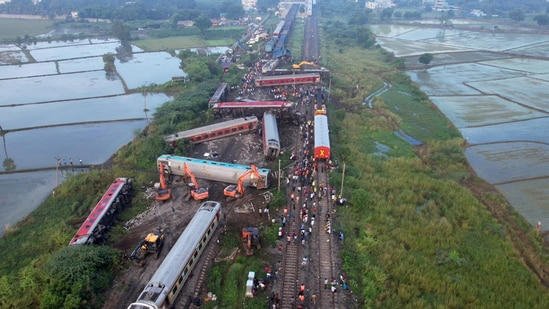A Darbhanga-bound express train collided with a stationary goods carriage, leading to severe disruptions and raising questions about railway safety protocols. The accident, which occurred in the early hours of the morning, has left many passengers injured, and authorities have launched an immediate investigation to determine the cause of this mishap.
What Happened?
The incident took place near the Chitteri railway station, approximately 60 kilometers from Chennai, when the Darbhanga Express, en route from Tamil Nadu to Bihar, rammed into a goods train that was reportedly halted on the same track. According to the official statement by the Indian Railways, the collision occurred at around 4:30 AM, catching passengers off guard as many were asleep at the time.
Rescue operations were launched swiftly with local authorities and railway personnel rushing to the spot. The injured were quickly transported to nearby hospitals, and the railway board dispatched a team to assess the damage and oversee the relief work.
Initial Investigation and Possible Causes
Railway officials have offered initial insights into what might have led to the collision. According to reports from the Southern Railway, the primary cause appears to be a lapse in signaling. The goods train was stationed on the main line due to technical issues, and a lack of proper communication between the control room and the train drivers may have caused the express train to move forward without realizing that the track was occupied.
“The root cause of the collision seems to be a failure in communication between the operations team and the driver of the Darbhanga-bound train. Preliminary findings indicate that the goods train was already stationed due to technical reasons, and the express train should have been redirected. However, a signaling error allowed the passenger train to proceed on the same track,” said a senior official from the Indian Railways.
This explanation suggests that a combination of human error and mechanical failure led to the tragic event, highlighting potential flaws in the signaling system. Indian Railways has been under pressure in recent years to upgrade its aging infrastructure, particularly in areas such as signal management, where modern technologies like automatic train protection systems have been suggested but are yet to be fully implemented across the network.
Track Maintenance and Signal System Failures
The stretch where the accident occurred is known for heavy train traffic, connecting Chennai with northern and eastern parts of India. Routine track maintenance and goods train movement are common, but the collision points to deeper issues in how maintenance schedules and goods train movement are coordinated with passenger trains.
One railway official explained that there might have been confusion at the control center, which resulted in the incorrect signal being sent to the Darbhanga Express. “We are reviewing whether there were any lapses in the system and what specific circumstances allowed the express train to proceed on the occupied track,” the official said.
Additionally, sources inside the investigation team mentioned that the goods train had been parked for an extended period due to technical malfunctions, but this information was not properly conveyed to the drivers of other trains.
Passengers’ Accounts and Relief Measures
Passengers on board the Darbhanga-bound express described scenes of chaos and confusion following the crash. “There was a loud noise, and the train jolted violently. People were thrown from their seats, and there was panic all around. It took a few moments to understand what had happened,” said a passenger who sustained minor injuries.
Rescue teams, including emergency medical personnel, arrived quickly, providing first aid and evacuating injured passengers. Indian Railways has announced compensation for the injured, and Railway Minister Ashwini Vaishnaw tweeted that an inquiry committee has been set up to probe the incident in detail.
Railway Safety and Infrastructure Issues
This accident has reignited concerns over railway safety and infrastructure in India, a country that boasts one of the largest rail networks in the world. While the government has been making strides to modernize the system with high-speed trains and safety upgrades, incidents like this highlight the persistent challenges of maintaining safe and efficient rail transport.
In response to the collision, many experts are calling for immediate attention to be given to signaling systems and communication protocols. Automatic warning systems that alert drivers when a track is occupied could have potentially prevented this collision. However, these technologies are still being rolled out across India’s vast rail network.
The collision of the Darbhanga-bound train with a goods carriage near Chennai has once again underlined the critical need for more robust safety measures in Indian Railways. While an official investigation is ongoing, the preliminary explanation points to a combination of human error and signaling failure. As the railway authorities address the aftermath of the accident, there is a growing demand for the modernization of India’s railway infrastructure to prevent such tragedies in the future.

